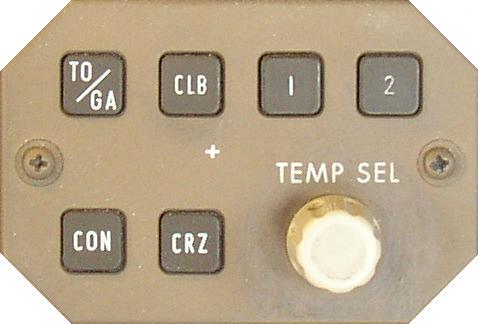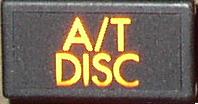Automatic Flight - Autothrottle 
- Limitations - Automatic Flight
- Limitations - Autoland
Autothrottle System
The Autothrottle system provides thrust control from takeoff through landing. Autothrottle mode and speed selection is controlled from the MCP and the Thrust Mode Select Panel (TMSP) and utilises the Thrust Management Computer (TMC). When in VNAV, the FMC selects Autothrottle modes and target thrust values.
- Refer to Flight Management, Navigation for FMS and CDU operation
On some airplanes, the FMC values can be overridden by selecting CON or CLB on the TMSP.
The Autothrottle can be operated without using the flight director or the autopilot.
The Autothrottle can be manually overridden or disconnected by using either Autothrottle disconnect switch.
Thrust Management Computer
- See also: Engines and APU - Controls
The Thrust Management Computer (TMC) controls the Autothrottle system through manual inputs from the MCP or automatically from the FMCs while VNAV is engaged. The TMSP allows for selecting Reference Thrust. The basic TMC functions are to:
- Calculate thrust limits and settings or follow FMC thrust settings.
- Detect and transmit Autothrottle failures.
- Actuate the thrust levers.
- Generate Fast/Slow indications for display on the ADIs.
Thrust Mode Select Panel

The TMSP provides the following functions:
- Selection of reference thrust modes (TO, GA, CLB, CON, CRZ).
- Selection of fixed and assumed temperature de-rated reference thrust values.
- See also: Engines and APU - Controls
Autothrottle Thrust Lever Operation
The Autothrottle system moves both thrust levers together, maintaining their relative positions, to control speed or thrust, depending on the engaged mode. Except when retarding thrust levers to idle, the first thrust lever reaching a forward or aft limit, causes both thrust levers to stop moving. If necessary, thrust may be equalised by manually repositioning the lagging thrust lever.
Thrust levers can be manually positioned without disconnecting the Autothrottle. After manual positioning the Autothrottle system repositions the thrust levers to comply with the computed thrust requirements of the engaged mode. The Autothrottle system does not reposition the thrust levers while in THR HOLD mode.
Autothrottle Disconnect
The Autothrottle system can be disconnected manually by positioning the A/T Arm Switch to OFF or by pushing either thrust lever A/T Disconnect Switch.
 Automatic autothrottle disconnect occurs if a fault in the active Autothrottle mode is detected, or when a reverse thrust lever is raised to reverse idle. The Autothrottle DISC light illuminates and the EICAS caution message AUTOTHROT DISC displays.
Automatic autothrottle disconnect occurs if a fault in the active Autothrottle mode is detected, or when a reverse thrust lever is raised to reverse idle. The Autothrottle DISC light illuminates and the EICAS caution message AUTOTHROT DISC displays.
Autothrottle Disconnect Warning
During normal system operation, the A/T completes a continuous self-test procedure. If the system detects an error, it will provide an aural warning and then disconnect. However, occasionally the system may detect an error and give an aural warning, but then recover and remain engaged, with no other indications displayed.